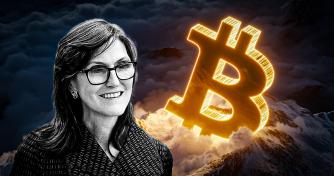 SBF Trial – Defense grills Singh over personal spending despite knowing FTX was misusing customer funds
SBF Trial – Defense grills Singh over personal spending despite knowing FTX was misusing customer funds SBF Trial – Defense grills Singh over personal spending despite knowing FTX was misusing customer funds
The tenth day of SBF's trial mainly revolved around the cross examination of Nishad Singh, who revealed further details about the infamous software bug that led to the $8 billion discrepancy in Alameda's accounts.

COVER ART/ILLUSTRATION VIA CRYPTOSLATE. IMAGE INCLUDES COMBINED CONTENT WHICH MAY INCLUDE AI GENERATED CONTENT
Nishad Singh, the former director of engineering at FTX, continued to testify and underwent rigorous cross-examination by defense lawyers on the tenth day of the Sam Bankman-Fried (SBF) trial.
Singh, who has previously stated that he felt intimidated and humiliated by SBF, continued to reveal insights into the inner workings of the cryptocurrency exchange and SBF’s activities.
Like previous witnesses — including Caroline Ellison and Gary Wang — Singh has pleaded guilty to fraud and conspiracy charges and has agreed to cooperate with prosecutors in their case against SBF.
The software bug
Singh’s cross-examination shed further light on a series of events leading up to the alleged misuse of billions of dollars in customer funds. The day was marked by revelations about Singh’s involvement and the extravagant spending culture at FTX.
Singh told the jury that he nearly resigned from FTX in the fall of 2022 after discovering the massive misuse of customer funds. He characterized the scale of wrongdoing as “enormous.”
Upon the defense’s questioning, Singh detailed the discovery of a software bug in Alameda’s balance in mid-June 2022, which had caused discrepancies totaling about $8 billion. The bug allowed Alameda to borrow billions from FTX users. It had been introduced inadvertently by a former employee and played a pivotal role in the company’s financial turmoil.
Singh said the bug had initially escaped his notice, and he only became aware of it after overhearing a conversation among FTX personnel.
Singh described the palpable sense of relief among team members when they discovered that the balance was negative $11 billion, not the initially feared negative $19 billion.
He told the courtroom that he believed FTX would continue to thrive “for years” even after learning about Alameda Research’s growing deficit in September 2022. He also revealed that SBF was absent from the meeting where the closure of Alameda was discussed.
He told the jury that ultimately, the discussions came to the conclusion that the challenges faced by Alameda, including its extensive use of crypto and customer funds deposited on FTX, made shutting down the trading firm seemingly impossible — a sentiment echoed by Caroline Ellison during her testimony earlier in the trial.
The donations & loans
Singh’s cross-examination covered his involvement in FTX’s political donations, campaign finance activities, and his personal spending using money borrowed from the exchange.
The defense questioned him about purchasing a luxury property on Orcas Island in October 2022 using $3.7 million that was borrowed from FTX, even after discovering that the exchange was misusing customer funds.
Singh expressed remorse and admitted that his spending on the property was “egregious, unnecessary, and selfish.” He stated:
“I was embarrassed and ashamed, and forfeiting seems to be one of the ways to right the wrong, at least a little.”
Singh also acknowledged his role as a straw donor to funnel donations to political campaigns, mainly to Democrats. He gave further details on the involvement of SBF’s brother, Gabriel Bankman-Fried, and mother, Barbara Fried, in determining where the donations should go.
The prosecution has released a complete list of all the donations FTX made to various political campaigns through its straw donor scheme.
Meetings with influential figures
In addition to political donations, the courtroom was presented with evidence of emails and cell phone data when the prosecution called FBI agent Richard Busick to the stand to discuss an analysis he did on an AT&T phone allegedly used by SBF.
The prosecution unveiled records of meetings and invitations involving SBF and influential figures during the testimony. This included an invitation to a Forbes photo shoot at the Equinox Hotel in Hudson Yards in September 2021.
Additionally, the records showed SBF had scheduled a dinner with New York City Mayor Eric Adams and a meeting with former President Bill Clinton during the UN General Assembly High-Level Week in September 2022.
An email was highlighted where the Prime Minister of the Bahamas sent a favor request to SBF. This email would later play a role in discussions related to allegations of campaign finance charges against the former billionaire.
The cross-examination phase was marked by swift questioning by the defense lawyer Mark Cohen, who focused on the validity of the phone data presented. He argued that the agent did not have knowledge of who was using the phone in question.
The session ended on a light note, with Judge Kaplan humorously announcing the jury’s release time.
Early conclusion likely
As the trial continues, a University of Notre Dame accounting professor is expected to testify as an expert witness to discuss FTX’s finances in the upcoming days.
The prosecution’s case is expected to continue until Oct. 26 or Oct. 27, after which the defense will present its theory of the case. Several key witnesses, including former FTX CEO Caroline Ellison and others, have testified.
SBF’s first criminal trial is anticipated to conclude in November, and he will face an additional five counts in a second trial scheduled to begin in March 2024. SBF has pleaded not guilty to all charges.
In related news…
SBF donated $230M to politicians, special interests
During the criminal trial of FTX founder Sam Bankman-Fried, evidence revealed over $230 million in donations to friends, family, politicians, PACs, and special interests.
Notable recipients include Mitt Romney and Cory Booker, with the majority going to political groups and PACs.
The list also features substantial gifts to family members and individuals connected to the effective altruism community, shedding light on the extent of SBF’s philanthropic activities.
FTX’s $9B customer refund plan
Bankrupt cryptocurrency exchange FTX aims to recover over $9 billion in customer funds through a proposed settlement.
Customers who withdrew more than they deposited within nine days before the platform’s bankruptcy filing might be required to return 15% of their net withdrawals. This move aims to address “preference” claims.
It would provide certainty to eligible customers if approved while facilitating FTX’s goal of returning customer funds by 2024. The proposal outlines the division of assets and potential clawbacks, with exceptions for certain categories of customers.














































































































